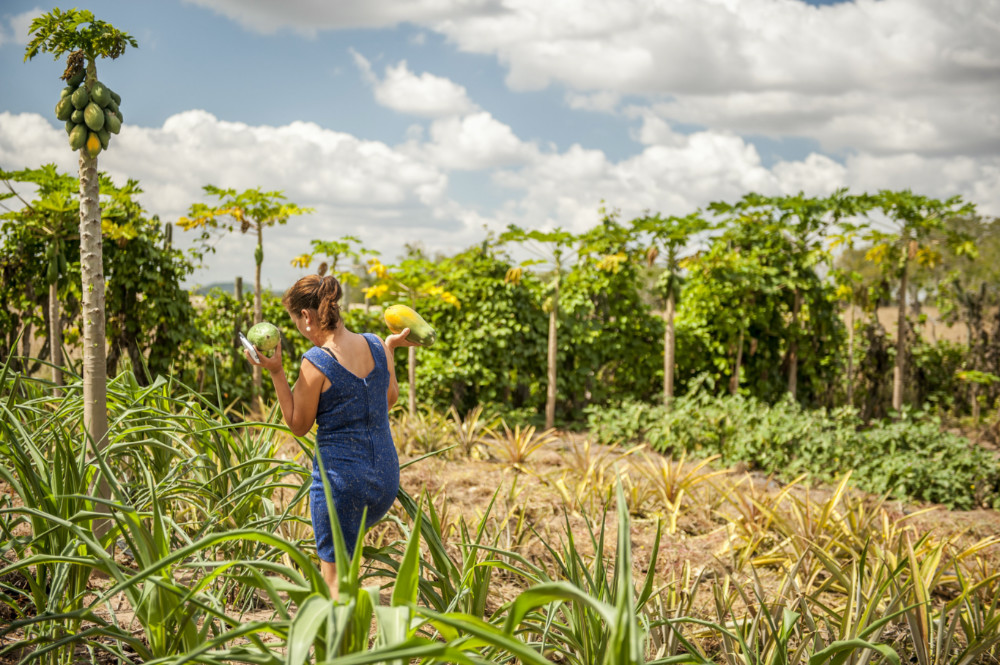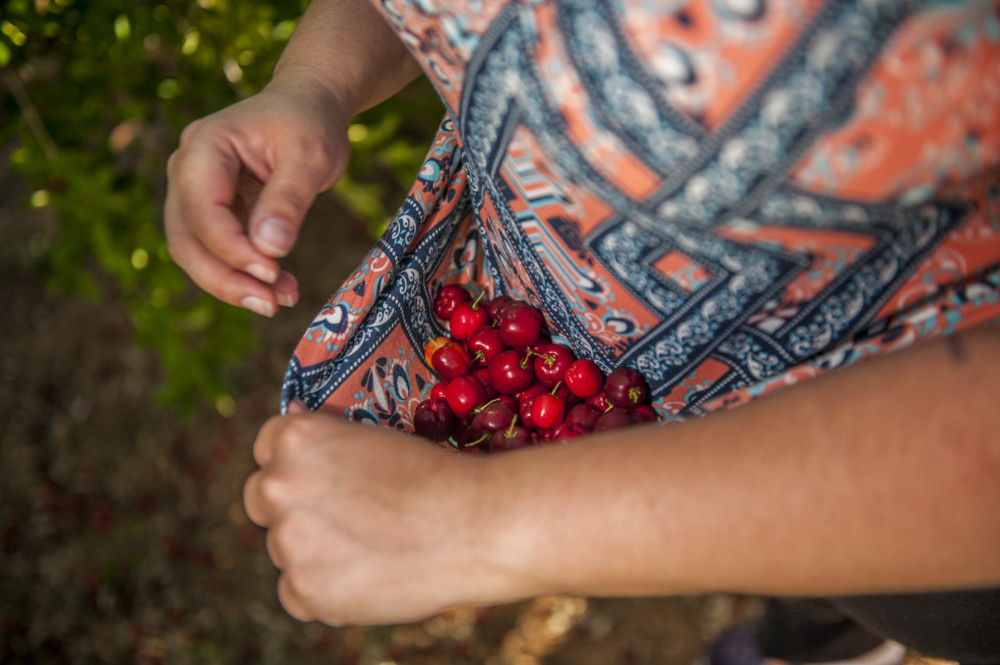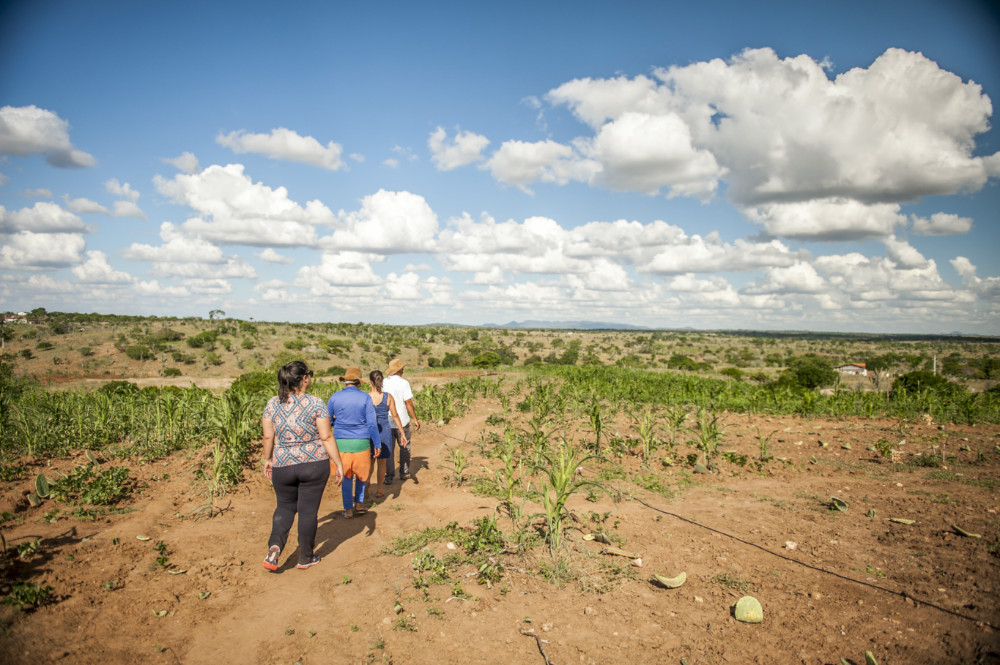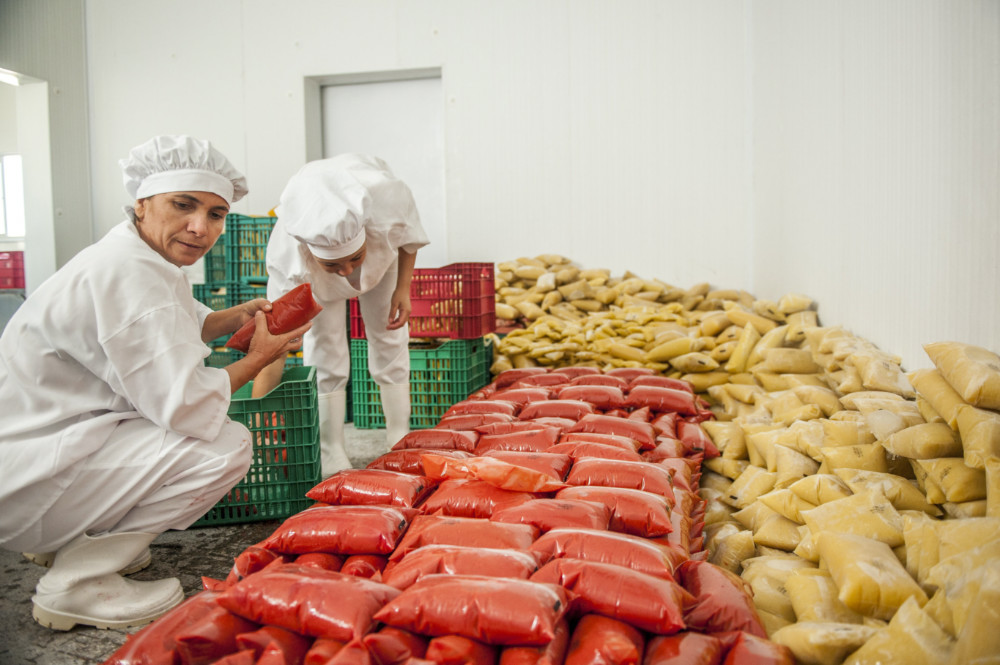
FABIO ZUKER, of Thomson Reuters Foundation, reports on how women farmers are using the umbu tree, which stores water in its roots, to help reforest the country’s semi-arid north-east…
Sao Paulo, Brazil
Thomson Reuters Foundation
When a TV crew visited Denise Cardoso’s farm in north-eastern Brazil, she and her grandfather cut open the chunky roots of an umbu tree to show how it stores water, even during drought.
The natural process they were demonstrating on that day four years ago normally guarantees the tree’s survival in the semi-arid climate of the Caatinga, a biome that covers more than 10 per cent of Brazil’s territory.
But when they opened the root, they got a shock.
“It was completely dry inside,” said Cardoso, 31, by phone from her home in the small municipality of Uauá in Bahia state. Neither she nor her grandfather had ever seen anything like it.
“We were terrified,” she told the Thomson Reuters Foundation.

A woman carries papayas planted by the Coopsertao cooperative in Pintadas, Brazil, on 19th July, 2016. PICTURE: Luiz Fernando Ricci/WRI Brasil .
Cardoso belongs to a cooperative called Coopercuc that grows umbu – also known as the Brazil plum – and other native plants to sell their fruit.
When she saw the withered inside of the roots, which she attributed to rising heat combined with a drought the region was then experiencing, she realised the cooperative would need to rethink the way it farmed, with a new goal: reforestation.
“[W]e started planning…thinking much more about sustainability. Because what is coming, we do not know.”
– Farmer Denise Cardoso
“From there we started planning…thinking much more about sustainability. Because what is coming, we do not know,” she said.
Now Coopercuc is one of several women-led cooperatives in the area aiming to help increase the number of trees while also providing a livelihood for the people living there.
Climatologist Francis Lacerda said hotter temperatures and creeping desertification are not limited to Uauá.
Changes across the Caatinga biome “are already happening, and much faster than the models suggest”, said Lacerda, a researcher at the Agronomic Institute of Pernambuco, run by the state government.
“The great droughts of the past lasted three, three-and-a-half years. The consecutive droughts today are lasting seven years,” said Lacerda, also a member of the National Institute of Science and Technology for Climate Change.
According to a 2019 study by the Federal University of Alagoas, in Bahia state alone, 16 per cent of land is impacted by desertification.
While studying climate change in semi-arid regions in Brazil’s north-east, Lacerda has seen a sharp drop in rainfall, with an increase in drought days and maximum temperatures.
In some places, precipitation patterns are also becoming more erratic, she added, as areas that used to get three months of rain a year are now going whole years with none or seeing it concentrated into short, intense storms.

A woman carries acerola fruit planted by the Coopsertao cooperative in Pintadas, Brazil, on 19th July, 2016. PICTURE: Luiz Fernando Ricci/WRI Brasil
In the Sertao do Araripe region of Caatinga, which Lacerda said is rapidly losing forests due to expanding agriculture and cattle farming, she found a temperature increase of nearly five degrees Celsius (nine degrees Fahrenheit) over the last 50 years.
The region used to experience an average of 33 mm of evaporation per day. “But today we can say that it is at least twice as much,” Lacerda said.
“The semi-arid [region] is becoming arid – agriculture has its days numbered here.”
Lacerda is sceptical about traditional engineering solutions such as constructing reservoirs to store water, which she said would evaporate quickly.
The answer, she said, lies in reforestation, with a focus on native trees like umbu, which she calls “water farms”.
“The semi-arid [region] is becoming arid – agriculture has its days numbered here.”
– Climatologist Francis Lacerda.
By storing water below the soil, the umbu helps fight aridification and soil erosion, she explained.
Knowing this, Coopercuc and other cooperatives across the north-east are combining fruit production with reforestation.
Members of Coopercuc, set up in 2004, grow umbu and other organic fruit trees in backyards that border each other, creating more than 10 small communal farms of one to two hectares each, explained Cardoso.
Since 2019, Coopercuc has been experimenting with “agrocaatinga”, their name for a local form of agroforestry, the practice of planting trees alongside or in between crops.
The cooperative intersperses their fruit trees with native Caatinga cacti and trees such as anjico, Cardoso said.
She estimated that the reforestation areas are already producing about 10 tonnes of food per year from trees including passion fruit, guava, cashew and mango, as well as up to 40 tonnes of umbu, which can be used for fruit pulp and jams.

Members of Coopsertao, one of the women-led cooperatives reforesting the Caatinga area, in Pintadas, Brazil, on 19th July, 2016. PICTURE: Luiz Fernando Ricci/WRI Brasil
Girlene Almeida Oliveira, a member of the Coopsertao cooperative, which is working in Pintadas in Bahia with support from the World Resources Institute, an environmental thinktank, said her group grows and processes 30 tonnes of umbu per year.
A decade ago, Brazilians saw no value in umbu trees and routinely cut them down to make way for pasture, Almeida Oliveira said.
“When people saw that the fruit paid off – that it had a market value – the interest in reforestation increased,” she said.
“Today, people leave it to regenerate,” she said, adding that, in some places, land which was once cleared for cattle-keeping is now “almost like a forest”.
Even with the efforts by local groups, the Caatinga is still losing its forests, mirroring the high rate of deforestation across Brazil.
Data from MapBiomas, an initiative of the Brazilian Climate Observatory, shows that 58 per cent of the biome was covered in natural forests in 2019, a two per cent drop from 15 years earlier.
This year, the COVID-19 pandemic has severely affected the reforestation initiatives in Caatinga, with Cardoso estimating Coopercuc’s revenue has fallen 70 per cent due to lockdown restrictions.
Coopsertao has been more affected by school closures, as the government is one of its main buyers, said Almeida Oliveira.
“In 2020, we didn’t sell even 10 per cent of what we used to sell,” she noted.
Nonetheless, the women plan to carry on.

Women sort through bags of fruit pulp produced by the Coopsertao cooperative in Pintadas, Brazil, on 18th July, 2016. PICTURE: Luiz Fernando Ricci/WRI Brasil
Cardoso, the first in her family to pursue a university education, now has a degree in administration which she paid for with the money she makes farming umbu and other native species.
The cooperative “transforms the lives of us women”, she said.
Almeida Oliveira highlighted another benefit.
“You no longer need to wait for the income of your husband [or] son. This work allows a financial gain that helps a woman’s self-esteem. Now, I have what is mine,” said the farmer.





